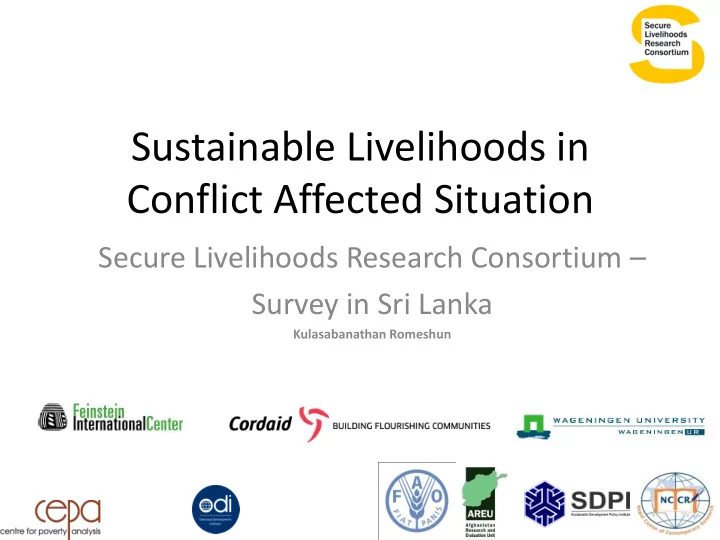

Sustainable Livelihoods in Conflict Affected Situation Secure Livelihoods Research Consortium – Survey in Sri Lanka Kulasabanathan Romeshun
Context • Sri Lanka had a 30 year armed conflict ending in May 2009 • Economic growth in North and East Provinces – 2010 came largely from expanding agriculture and fisheries – Subsequent years from construction and growing industry and services sector – Highest economic growth rates amongst the 9 Provinces in 2012
SLRC Survey • Covering 1377 Households (95% level of statistical confidence) • Conducted in September- October 2012 • Districts (3) selected purposively capture geographic variation in conflict and return, resettlement and recovery • 66% of the sampled Households were Tamil • Villages purposively chosen to represent near shore fishing community
Key Shock - Displacement 1% 3% 6% 14% Still in 84% displacement 98% 89% Displaced and 85% resettled Never displaced 13% 5% 1% 1% Mannar Jaffna Trinco All
Displacement and Household Income Earners 3.00% 8.40% 9.20% 8.90% 22% 19% 23% 23% 63% 70% 63% 63% 12% 5% 5% 2% Displaced and Still in displacement Never displaced All resettled None One Two Three or more
Measuring Livelihood Outcomes • Food Insecurity Index - proxy by a measure of food insecurity based on the food insecurity coping strategies index ( Maxwell, 2003) • Asset Index- proxy by the assets owned by the household using the Morris score index (Morris et al., 1999)
Household Food Insecurity • 61 % of households fell below the mean • Only 15.7% had to adopt coping strategies four to five times during the period in question • 35% of households did not use any coping strategies • The regression analysis results suggest – Lower in households with higher number of working age population – Lower in households with higher levels of educational attainment – Lower in households which are asset rich – Displaced and resettled show high food insecurity compared to still displaced and never displaced – Households engaged in fisheries, agriculture and trade high levels of food insecurity vs Households in public sector employment – Higher in households with more women earners
Household Wealth • The asset index score indicates that majority of households own fewer assets than the mean. • The recency of conflict has a bearing on household wealth • Never displaced reported higher wealth with still in displacement reporting lower wealth • Households in public sector employment higher wealth as opposed to Households engaged in fisheries, agriculture and trade • Households with higher educational attainment are asset rich • Households with migrated members are asset rich • Female headed households are asset poor
Debt All Still Never Resettled displaced displaced In debt 70.1% 64.2% 61.4% 69.3% Have bank savings Acct 73.9% 74.6% 75.9% 74.1% Source of credit (for those who borrowed) Formal lender/bank 53.3% 51.2% 49.0% 53.1% Informal money lender 20.2% 7.0% 15.7% 19.5% Family/friends 31.0% 46.5% 31.4% 31.9% Employer 12.1% 0.0% 0.0% 10.9% Savings group 3.1% 9.3% 11.8% 3.9% Reason for borrowing (for those who borrowed) Productive purpose 59.3% 46.5% 54.9% 58.4% To meet food and clothing exp. 31.5% 44.2% 29.4% 32.0% To meet health expenses 19.8% 20.9% 5.9% 19.0% To meet Education expenses 4.9% 2.3% 2.0% 4.6%
Livelihood Support Services • Asset rich households are seen to receive livelihood support services • Receiving households report positive perceptions about the support received • Response to submissions on livelihood related issues still remain low
Conclusion • The end of war has created a positive environment for livelihood activities to develop • Education is a means to increasing livelihood outcomes • Vulnerable groups exist that are still not able to make use of opportunities – Still in displacement – Resettled – Women headed household
Thank you
12 Section Questionnaire Questionnaire had 12 Sections on • A. Basic Pre-interview information • B. Basic Household information • C. Basic individual information • D. Assets • E. Livelihood sources • F. Food security • G. Shocks experienced by the Household • H. Crime and safety • I. Basic services • J. Social protection • K. Livelihood services • L. Service delivery process
Surveyed Districts
Sample by Ethnic Composition 100.00% 80.00% 60.00% Other Sri Lanka Moor Tamil 40.00% Sinhala 20.00% 0.00% Mannar Jaffna Trincomalee
Primary Occupation Public sector Other jobs 3% 9% Agriculture 9% Fisheries 40% Trading 39%
Service Delivery Issues and Response Social Livelihood Health Education Water protection services Overall Had service delivery issues and knew how to make a complaint 64.6% 61.7% 68.5% 60.5% 55.8% 67.5% Knew how to make a complaint and who actually complained 84.6% 75.6% 87.2% 82.7% 84.7% 88.8% Complained to the local/ central government/elected politician/ defence force 85.3% 81.3% 87.5% 88.4% 94.2% 84.5% Complained to government and received response to complaint 48.4% 48.7% 57.9% 44.7% 31.5%% 51.2%
Educational Attainment • 98.8% percent of children aged 5-14 year enrolled in School – National average 99.4% • Individuals over 14 years of age, – Never been to school • 2.7% compared to national average of 4.2% • 58% over 45 years of age • 59% female – More than 13 years of schooling • 2.7 percent compared to national average of 14.7%
Recommend
More recommend